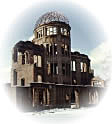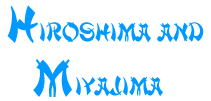Our
last day in Osaka arrived and we sadly looked forward to our last
full day in Japan before returning home and ending this month long
vacation to some of the most wonderful places on Earth. For our last
day we had something special planned, something we viewed as a "must"
for our trip to Japan: A visit to Peace Park in Hiroshima,
Japan. I can't tell you when it happened, or exactly why it happened,
but one of the things I've always wanted to do (and I set a goal for
myself to do it) was ring the Peace Bell in Peach Park. Hiroshima
was the scene of one of worst nightmares man could ever imagine, the
likes of which I hope this world never sees again. In the flash of
a light thousands died and millions suffered. That suffering continued
for years and, for some, it continues even today. Because of what
happened at Hiroshima that one August morning the world and its people
will never be the same again. I sincerely hope that the belief we,
the Americans who dropped the bomb, had that dropping such a catastrophic
bomb would end the war sooner and save countless lives on all sides
was a correct one. Ringing the Peace Bell for Anne and I would be
our vote, our little voice, for world peace among nations and all
mankind. We had looked forward to this day for a very long time and
it had finally arrived.
We awoke early and did our final packing in preparation for leaving.
Kako would drive us to the train station where we would catch the
Shinkaseen bullet train to Hiroshima. We were in for somewhat of a
surprise though. During the night it had snowed and there was several
inches of snow on the ground and streets. We made it to the train
station in time for our train only to find that it was delayed. We
waited patiently and worried that it might affect our trip. Hiroshima
was a full 200+ miles in the opposite direction from Tokyo and we
had to make it back to Tokyo that night for our flight home the next
day.
After a short time there was an announcement concerning our train
over the PA in Japanese of course. Thank goodness Kako was with us
and translated the bad news immediately for us. Our train to Hiroshima
had been canceled due to the inclement weather with downed trees and
lines between Osaka and Hiroshima. Anne's and my heart fell right
to the floor with that news. We had come so far and were in sight
of our goal only to have it snatched away by some stupid snow storm.
We were both devastated and disappointed. Coming to grips with the
situation and figuring there was nothing we could do we changed our
Hiroshima tickets for tickets to Tokyo. We tried to console ourselves
by thinking that we'd have most of the day sightseeing in Tokyo, but
that didn't help eliminate the great disappointment we felt.
Once again we found ourselves waiting by the tracks for the train
bound for Tokyo to arrive when another announcement came over the
PA. Again, we were thankful that Kako was there to interpret. This
announcement brought good news. The trains to Hiroshima were running
again and one would be along in a short time. We quickly changed our
tickets back to Hiroshima and we both felt a great burdened lift from
our shoulders. At this point we knew one thing: We would get to Hiroshima
and we would ring the Peace Bell. I really didn't care if we couldn't
make it back to Tokyo that night or not and missed our flight home.
There's always another flight, but there may never be a chance to
ring the Peace Bell again. The train arrived and we were finally on
our way to Hiroshima.
Arriving in Hiroshima we stowed our luggage and took a cab to Peace
Park. |
|
|
|
|
|
|
|
|
|
|
|
|
|
|
|
Peace
Memorial Park
|
|
|
|
|
|
|
|
|
|
|
|
|
|
|
|
|
|
|
|
|
|
|
|
|
|
|
|
|
|
|
| Peace
Memorial Park is located in the center of Hiroshima not far from the
center of the bombed area. The photo left shows the main park area
with the eternal Peace Flame monument and, behind that, the remnants
of the Hiroshima Perfectural Promotion Hall, one of the only structures
that withstood the atomic bomb blast. |
|
|
|
|
|
|
|
|
|
|
|
|
|
|
| Today
Peace Memorial Park houses the Peace Memorial Museum, a must see for
any visitor to Japan. It contains many interesting exhibits relating
to the atom bomb and the actual bombing of Hiroshima and the after
effects of the bombing. Peace Memorial Park and the museum is dedicated
to the children who lost their lives in the bomb blast and its aftermath. |
|
|
|
|
|
|
|
|
|
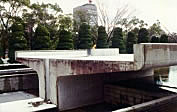 Eternal
Peace Flame
Eternal
Peace Flame |
|
|
|
|
|
|
|
|
|
|
|
|
|
|
| Inside
the museum there are many moving reminders of the devastation a single
atomic bomb can have on a population. One of the most thought provoking
for me was the sight of granite steps showing the shadow of a person
who had been sitting on the steps when the bomb exploded at 8:15 a.m.
the morning of August 6, 1945. Another was of a watch stopped at the
precise moment the bomb detonated. |
|
|
|
|
|
|
|
|
|
|
|
|
|
|
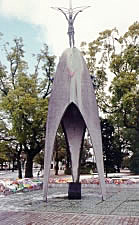 Memorial
to a little girl who
Memorial
to a little girl who
died as a result of the bomb |
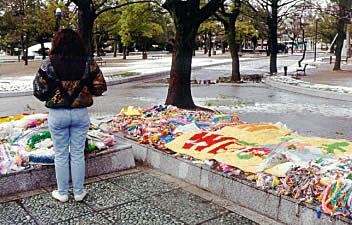 Anne
viewing the little oratani figures left by the
Anne
viewing the little oratani figures left by the
Japanese school children |
|
|
|
|
|
|
|
|
|
|
|
|
|
|
| Throughout
the park there are various monuments. One of the most striking and
memorable is to a little girl who died from the after effects of the
bombing in 1955. In the hospital she began to make little paper oratani
figures thinking they would keep her alive, but they didn't. Today
the monument is a favorite amongst the Japanese school children. In
preparation for their visit they make the little paper oratani figures
and leave them at the monument as a tribute to the little girl. One
cannot stand by this monument and not be affected by it. |
|
|
|
|
|
|
|
|
|
|
|
|
|
|
|
Hiroshima
Prefectural Promotion Hall
|
|
|
|
|
|
|
|
|
|
|
|
|
|
|
|
|
This,
perhaps, is one of the most recognized buildings in the world today.
Anyone who has ever seen a documentary on Hiroshima has certainly
seen this building before. The epicenter of the bomb's blast was only
about 450 feet southeast and 1,800 feet above this building. The 30
occupants were killed by the blast but, somehow, the building survived.
Inside of the museum they have a model of Hiroshima showing the city
following the blast, and this building is the only standing structure
with the exception of a few smokestacks. It stood out amongst a backdrop
of total devastation.
Anne and I walked around the building to see it from all perspectives
as it was hard to imagine that this one building could withstand such
devastating forces as those caused by the atom bomb. Somehow it did
manage to survive and serves today as a reminder of how that day in
August 1945 affected everyone living today. |
|
|
|
|
|
|
|
|
|
|
|
|
|
|
|
|
|
|
|
|
|
|
|
|
|
|
|
|
|
|
|
|
|
|
|
|
|
|
|
|
|
|
|
|
|
|
|
|
|
|
|
|
|
|
|
|
|
|
|
Having
visited the museum and walked throughout the park there remained but
one thing for Anne and I to do: Ring the Peace Bell as a symbol of
our want and desire for world peace for all mankind. This was the
reason we came to Hiroshima in the first place and it would be the
last thing we did there. |
|
|
|
|
|
|
|
|
|
|
|
|
|
Bell
of Peace
|
|
|
|
|
|
|
|
|
|
|
|
|
|
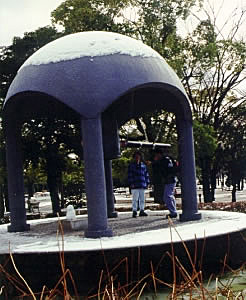
The
Bell of Peace |
|
|
|
|
|
|
We
dedicate this bell
As a symbol of Hiroshima aspiration
Let all nuclear arms and wars be gone,
and the nations live in true peace!
May it ring to all corners of the Earth
to meet the ear of every man,
for in it throb and palpitate
the hearts of its peace - loving donors.
So may you, too, friends,
step forward, and toll this bell for peace!
|
|
|
The
Bell of Peace was dedicated on September 20th, 1964
by Hiroshima Higan-No-Kai
|
|
|
|
|
|
|
|
|
|
|
|
|
|
|
|
|
|
|
Anne
and I ringing the Bell of Peace
Peace Park, Hiroshima, Japan
|
|
|
|
|
|
|
|
|
|
|
|
|
|
|
|
| Having
achieved our goal of visiting Peace Memorial Park, its museum, and
ringing the Peace Bell Anne and I found that we still had some time
and daylight left before our scheduled train back to Tokyo. We got
adventurous and decided to visit Miyajima, the Scared Island.
This was no easy feat. First we needed to take a train to Miyajimaguchi
and then a ferry across to the Miyajima. When we boarded the train
we had no idea if it was the right one or not. Fortunately for us
it was and we arrived at our destination quickly. |
|
|
|
|
|
|
|
|
|
|
|
|
|
|
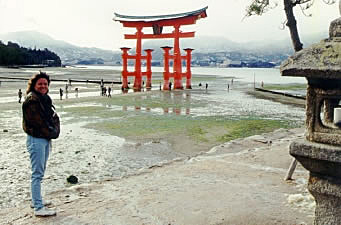 Anne
with the Torii gate in the distance
Anne
with the Torii gate in the distance |
Miyajima
is one of the most scenic spots in all of Japan. Exceptionally beautiful
the island has been held sacred since ancient times. It's most noticeable
feature is the huge vermilion painted Torii gate, built in
1875, which stands at the waters edge. It is the largest torii gate
in Japan standing 53 feet high. It stands guard over Miyajima's most
famous attraction the Itsukushima Shrine. Being a sacred island
no one was allowed to give birth or die on the island in ancient times.
The pregnant and sick were immediately ferried to the mainland.
The torii gate and Itsukushima Shrine are built on the water's edge
so that at high tide the water actually comes under the gate and shrine.
As you can see by the picture (left) we missed the high tide, but
it was still beautiful. |
|
|
|
|
|
|
|
|
|
|
|
|
|
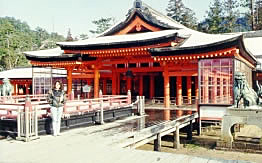 Anne
in front of the Itsukushima Shrine
Anne
in front of the Itsukushima Shrine |
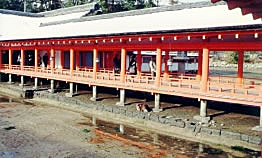 Tame
deer taking refuge below
Tame
deer taking refuge below |
|
|
|
|
|
|
|
|
|
|
|
|
|
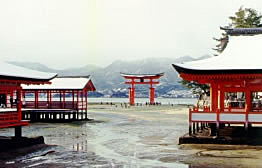 The
Torii Gate as seen from
The
Torii Gate as seen from
Itsukushima Shrine |
|
|
|
|
|
| When
our day at Miyajima ended it was hard to believe that our trip was
over and it was now time to head back home. Back to the snowy and
cold New Jersey climate, but that's what we had to do. Join us on
the last page for notes about the trip home ... |
